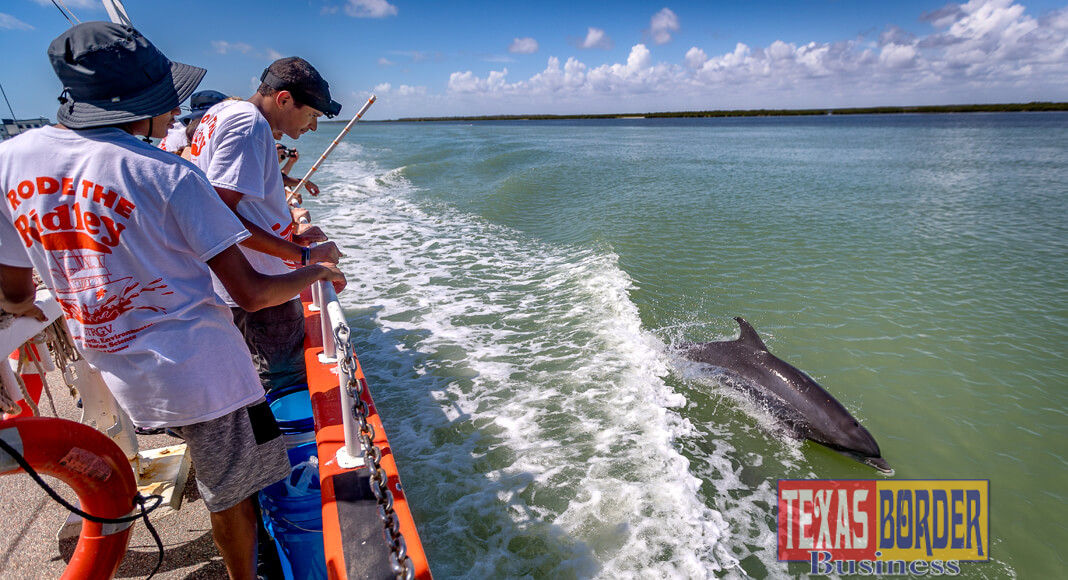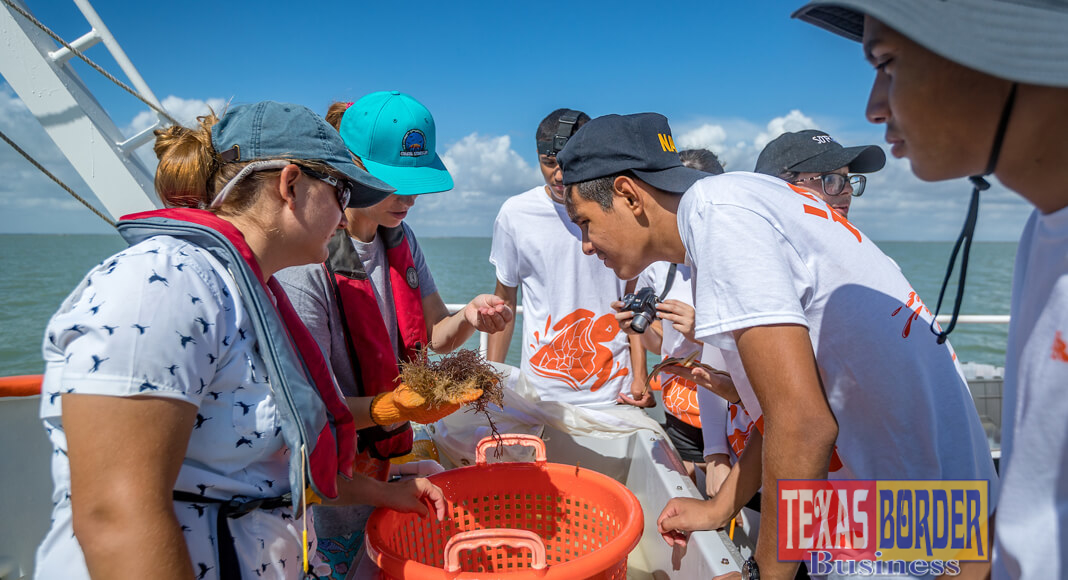
UTRGV Marine Ecology Camp teaches area high school students about marine research, human footprint
By Amanda A. Taylor
Texas Border Business
RIO GRANDE VALLEY, TEXAS – The loud rumbling of the Ridley’s boat motor could barely drown out the shouts of delight and awe as the high school students scrambled about the starboard rail to catch a glimpse of a creature some had never seen before.
“It’s a dolphin!” one excited student said. “There’s two of them!” another chimed in.
A small pod of dolphins was trailing alongside the Ridley, their silvery heads breaking in and out of the boat’s wake during a recent Hands-On Marine Ecology Camp field trip offered by the UTRGV Coastal Studies Laboratory, a facility of the School of Earth, Environmental and Marine Sciences (SEEMS).
Students held out their smart phones in hopes of capturing the perfect picture to keep as just one of the many memories collected on the vessel that day. From dolphins to blowfish, they were able to see and touch some of the unique creatures living in the Gulf of Mexico and learn how each creature is affected by our human footprint.
The Ridley, UTRGV’s learning mobile lab, hosted the high school students from around the Valley for a six-hour cruise along the bay and into the Arroyo Colorado. As part of a working research voyage, the group swapped out umbrellas and beach towels for discovery scopes and fluorescent lights, to learn how to gather and record samples for testing.
“This is a hands-on camp for high school students which affords them the opportunity to expand on what they’ve learned in the classrooms – the theory and principles that are involved in marine ecology – and put them into practice here in the field,” said Joseph Kowalski, a biologist and UTRGV research associate.
Students got to test their marine ecology skills out on the open water after a week of learning at the UTRGV Coastal Studies Labs in Port Isabel. The students, mostly incoming seniors, were able to interact with professional scientists and learn how to become more environmentally responsible adults.

On the Ridley, the students tested the primary productivity of photosynthesis via changing factors such as light, nutrients and light penetration in the water along the Laguna Madre.
“We’re studying saturation and dissolved oxygen, so we left these samples alone four hours in a sealed environment, with no light, so there wouldn’t be any plankton for respiration,” said Daniel Santos, a student at Lamar Academy in McAllen. “This would lower the amount of dissolved oxygen and the percentage of saturation, which we’ve recorded.”
The Marine Ecology Camp’s primary focus was to allow students to learn the production patterns in the Laguna Madre, but students also were testing changes in salinity as they moved from the Laguna Madre into the Arroyo Colorado, which introduces fresh water into the region.
“The Arroyo Colorado is a freshwater agricultural and municipal drain, so when it rains or when people take showers or flush toilets, it goes into the arroyo for a portion of the Valley,” Kowalski said. “All that water ends up in the ocean, so what we are doing is trying to understand the influence of a freshwater source and determining its influence on phytoplankton – plankton consisting of microscopic plants – and animal abundance.”
By the end of the camp, students had learned about faunal diversity along the salinity gradient in the Laguna Madre – basically, what kinds of fauna are found along the route, given the varying levels of salt in the water – as well as the diversity of plankton along that gradient. They also investigated the presence of plastic marine debris within the area, and conducted tests to study the human influence on marine life.
“We did two tests to look for the human footprint, one dealing with optimal brighteners,” Kowalski said. “When you wash clothes and they start to fade, you use detergents like Tide because they have optical brighteners, but this is also a parallel indicator for pollution because that waste water goes into the arroyo.”
It was the first time on a boat for some of the students, much less conducting tests like actual marine ecologists.
“It’s been a really neat experience,” said Josiah Cabela, a homeschooled student from McAllen. “I got to see a blowfish. It was my first time seeing a blowfish and we got to take all these water samples from three different sites.”
Kowalski stressed the importance of being able to apply the scientific approaches learned during the camp to the real world, regardless of what field of study students wanted to pursue.
“The scientific method is the scientific method, and it works no matter what field you go into. So it’s the approach to thinking and problem solving that is really more valuable than the details of marine ecology,” he said. “The marine ecology is a vehicle to become better informed scientists, better informed thinkers and problem solvers for the future.”














